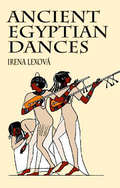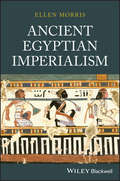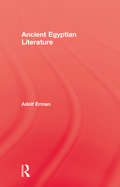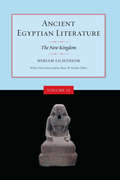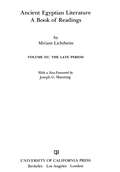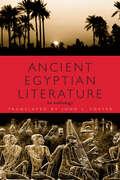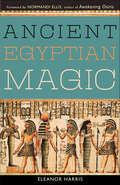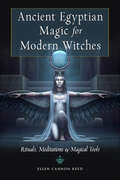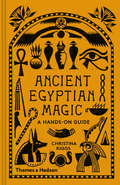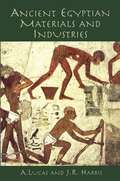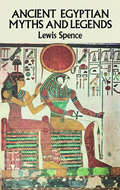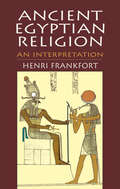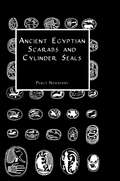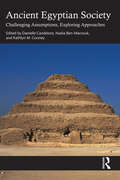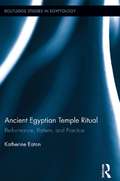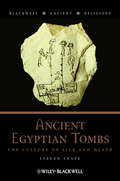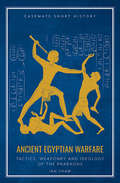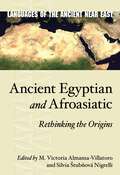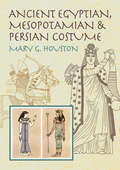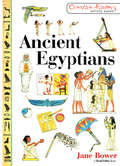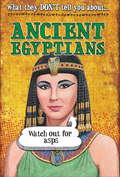- Table View
- List View
Ancient Egyptian Dances
by Irena LexováDancing was important to the ancient Egyptians. One of the few books available in English on this topic, this carefully researched, profusely illustrated work investigates the origins, nature and role of dance in Egyptian culture. Features 80 figure drawings and illustrations adapted from tomb paintings, reliefs, other authentic sources. New introduction. Bibliography.
Ancient Egyptian Gods and Goddesses (Ancient Egyptian Civilization Ser.)
by Christopher ForestAncient Egyptians relied on gods and goddesses every day to rule the sky, bring the rain, and more. Find out why the Egyptians worshipped these powerful beings and the roles they played in everyday life.
Ancient Egyptian Imperialism
by Ellen MorrisOffers a broad and unique look at Ancient Egypt during its long age of imperialism Written for enthusiasts and scholars of pharaonic Egypt, as well as for those interested in comparative imperialism, this book provides a look at some of the most intriguing evidence for grand strategy, low-level insurgencies, back-room deals, and complex colonial dynamics that exists for the Bronze Age world. It explores the actions of a variety of Egypt’s imperial governments from the dawn of the state until 1069 BCE as they endeavored to control fiercely independent mountain dwellers in Lebanon, urban populations in Canaan and Nubia, highly mobile Nilotic pastoralists, and predatory desert raiders. The book is especially valuable as it foregrounds the reactions of local populations and their active roles in shaping the trajectory of empire. With its emphasis on the experimental nature of imperialism and its attention to cross-cultural comparison and social history, this book offers a fresh perspective on a fascinating subject. Organized around central imperial themes—which are explored in depth at particular places and times in Egypt’s history—Ancient Egyptian Imperialism covers: Trade Before Empire—Empire Before the State (c. 3500-2686); Settler Colonialism (c. 2400-2160); Military Occupation (c. 2055-1775); Creolization, Collaboration, Colonization (c. 1775-1295); Motivation, Intimidation, Enticement (c. 1550-1295); Organization and Infrastructure (c. 1458-1295); Outwitting the State (c. 1362-1332); Conversions and Contractions in Egypt’s Northern Empire (c. 1295-1136); and Conversions and Contractions in Egypt’s Southern Empire (c. 1550-1069). Offers a wider focus of Egypt’s experimentation with empire than is covered by general Egyptologists Draws analogies to tactics employed by imperial governments and by dominated peoples in a variety of historically documented empires, both old world and new Answers questions such as “how often and to what degree did imperial blueprints undergo revisions?” Ancient Egyptian Imperialism is an excellent text for students and scholars of history, comparative history, and ancient history, as well for those interested in political science, anthropology, and the Biblical World.
Ancient Egyptian Literature
by Adolf ErmanThis book is an impressive collection of some of the earliest literature still extant from the great Ancient Egyptian civilization. Much of the material contained in this work -- poems, narratives, songs and prayers -- was translated here and made accessible to lovers of antiquity for the first time. Covering a range of topics including schools, religion and love, the collected works here provide the reader with a deeper understanding of ancient life along the Nile.
Ancient Egyptian Literature
by Miriam Lichtheim Antonio LoprianoFirst published in 1973 - and followed by Volume II in 1976 and Volume III in 1980 - this anthology has assumed classic status in the field of Egyptology and portrays the remarkable evolution of the literary forms of one of the world's earliest civilizations. Volume I outlines the early and gradual evolution of Egyptian literary genres, including biographical and historical inscriptions carved on stone, the various classes of literary works written with pen on papyrus, and the mortuary literature that focuses on life after death. Introduced with a new foreword by Antonio Loprieno. Volume II shows the culmination of these literary genres within the single period known as the New Kingdom (1550-1080 B.C.). With a new foreword by Hans-W. Fischer-Elfert. Volume III spans the last millennium of Pharaonic civilization, from the tenth century B.C. to the beginning of the Christian era. With a new foreword by Joseph G. Manning.
Ancient Egyptian Literature
by Miriam Lichtheim Hans-W Fischer-ElfertFirst published in 1973 - and followed by Volume II in 1976 and Volume III in 1980 - this anthology has assumed classic status in the field of Egyptology and portrays the remarkable evolution of the literary forms of one of the world's earliest civilizations. Volume I outlines the early and gradual evolution of Egyptian literary genres, including biographical and historical inscriptions carved on stone, the various classes of literary works written with pen on papyrus, and the mortuary literature that focuses on life after death. Introduced with a new foreword by Antonio Loprieno. Volume II shows the culmination of these literary genres within the single period known as the New Kingdom (1550-1080 B.C.). With a new foreword by Hans-W. Fischer-Elfert. Volume III spans the last millennium of Pharaonic civilization, from the tenth century B.C. to the beginning of the Christian era. With a new foreword by Joseph G. Manning.
Ancient Egyptian Literature
by Joseph G. Manning Miriam LichtheimFirst published in 1973 - and followed by Volume II in 1976 and Volume III in 1980 - this anthology has assumed classic status in the field of Egyptology and portrays the remarkable evolution of the literary forms of one of the world's earliest civilizations. Volume I outlines the early and gradual evolution of Egyptian literary genres, including biographical and historical inscriptions carved on stone, the various classes of literary works written with pen on papyrus, and the mortuary literature that focuses on life after death. Introduced with a new foreword by Antonio Loprieno. Volume II shows the culmination of these literary genres within the single period known as the New Kingdom (1550-1080 B.C.). With a new foreword by Hans-W. Fischer-Elfert. Volume III spans the last millennium of Pharaonic civilization, from the tenth century B.C. to the beginning of the Christian era. With a new foreword by Joseph G. Manning.
Ancient Egyptian Literature: A Book Of Readings
by Miriam LichtheimFirst published in 1973, this anthology has assumed classic status in the field of Egyptology and portrays the remarkable evolution of the literary forms of one of the world’s earliest civilizations. Beginning with the early and gradual evolution of Egyptian genres, it includes biographical and historical inscriptions carved on stone, the various classes of works written with pen on papyrus, and the mortuary literature that focuses on life after death. It then shows the culmination of these literary genres within the single period known as the New Kingdom (1550–1080 B.C.) and ends in the last millennium of Pharaonic civilization, from the tenth century B.C. to the beginning of the Christian era. An introduction written in three parts by Antonio Loprieno, Hans-W. Fischer-Elfert, and Joseph G. Manning completes this classic anthology.
Ancient Egyptian Literature: An Anthology
by John L. FosterA beautifully translated collection sampling all the major genres of ancient Egyptian literature.Poetry, stories, hymns, prayers, and wisdom texts found exquisite written expression in ancient Egypt while their literary counterparts were still being recited around hearth fires in ancient Greece and Israel. Yet, because of its very antiquity and the centuries during which the language was forgotten, ancient Egyptian literature is a newly discovered country for modern readers.This anthology offers an extensive sampling of all the major genres of ancient Egyptian literature. It includes all the texts from John Foster’s previous book Echoes of Egyptian Voices, along with selections from his Love Songs of the New Kingdom and Hymns, Prayers, and Songs: An Anthology of Ancient Egyptian Lyric Poetry, as well as previously unpublished translations of four longer and two short poems. Foster’s translations capture the poetical beauty of the Egyptian language and the spirit that impelled each piece’s composition, making these ancient masterworks sing for modern readers. An introduction to ancient Egyptian literature and its translation, as well as brief information about the authorship and date of each selection, completes the volume.“This exceptional sampling of one of the world’s most ancient literatures offers more than 40 hymns, stories, prayers, and songs revolving around religion, the Pharaohs, life, death, love, and more. . . . . Highly recommended for all literary collections, this is also of interest to comprehensive collections of Egyptology, Near Eastern history, world literature in translation, and religion.” —Library Journal“Older than the Buddha and the Bhagavad Gita, these poems constitute a truly ancient literature, and Foster’s rich and textured translations make genuine love poems and exhortations to the gods out of what, to most of us, are just pictures.” —Booklist
Ancient Egyptian Literature: An Anthology
by John L. FosterA beautifully translated collection sampling all the major genres of ancient Egyptian literature.Poetry, stories, hymns, prayers, and wisdom texts found exquisite written expression in ancient Egypt while their literary counterparts were still being recited around hearth fires in ancient Greece and Israel. Yet, because of its very antiquity and the centuries during which the language was forgotten, ancient Egyptian literature is a newly discovered country for modern readers.This anthology offers an extensive sampling of all the major genres of ancient Egyptian literature. It includes all the texts from John Foster’s previous book Echoes of Egyptian Voices, along with selections from his Love Songs of the New Kingdom and Hymns, Prayers, and Songs: An Anthology of Ancient Egyptian Lyric Poetry, as well as previously unpublished translations of four longer and two short poems. Foster’s translations capture the poetical beauty of the Egyptian language and the spirit that impelled each piece’s composition, making these ancient masterworks sing for modern readers. An introduction to ancient Egyptian literature and its translation, as well as brief information about the authorship and date of each selection, completes the volume.“This exceptional sampling of one of the world’s most ancient literatures offers more than 40 hymns, stories, prayers, and songs revolving around religion, the Pharaohs, life, death, love, and more. . . . . Highly recommended for all literary collections, this is also of interest to comprehensive collections of Egyptology, Near Eastern history, world literature in translation, and religion.” —Library Journal“Older than the Buddha and the Bhagavad Gita, these poems constitute a truly ancient literature, and Foster’s rich and textured translations make genuine love poems and exhortations to the gods out of what, to most of us, are just pictures.” —Booklist
Ancient Egyptian Magic
by Eleanor L. HarrisTakes readers through the fundamentals of Egyptian magic, its techniques, rituals, magical formulas.Ancient Egyptian Magic takes readers step by step through the Egyptian philosophy and practice of magic. The author, Eleanor L. Harris, is a long-time practitioner of Egyptian magic, and she explains the "hows" and "whys" of magical tools, amulets, rituals, ceremony, and spells. Advanced practitioners will find especially useful instruction on actual Egyptian magical script as found in the ancient papyri, such as The Leyden Papyrus, The Papyrus Ani (the Egyptian Book of the Dead), and other important works. You will learn how to: • Invoke Egyptian gods and spirits for divination and magic • Scry with fire, oil, and water • Evoke messengers and spirits of the dead • Have dream visions • Sound the secret names of the deities • Shape-shift into god forms • Cast spells for love, protection, and healing • Create ritual clothing and magical tools There is a glossary of deities and terms, along with a list of resources for more information on specialty items to outfit the detail-oriented magician.
Ancient Egyptian Magic for Modern Witches: Rituals, Meditations, and Magical Tools
by Ellen Cannon ReedRituals, prayers, and songs to bring the wisdom of the gods and goddesses of ancient Egypt to life.Based on Ellen Cannon Reed's twenty-five years of work with deities of ancient Egypt, this book brings an ancient tradition to modern pagan practice. With it, readers will have the tools to continue learning and developing their own methods of honoring the gods and goddesses of ancient Egypt.Over two dozen gods and goddesses are highlighted, including Osiris, Isis, Ra, Bast, Thoth, Sekhmet, and Tefnut. There is also a section devoted to glyphs. Finally, meditations and techniques bring these deities to life, enriching your spiritual path.The book provides a host of tools and techniques:•Songs for the deities•Rituals for ancient gods and goddesses•Instructions for making your own magical tools•Information about hieroglyphs•Guides to making incense and oils•Recipes for an ancient Egyptian feastPreviously published as Circle of Isis.
Ancient Egyptian Magic: A Hands-on Guide
by Christina RiggsAn entertaining and informative introduction to how ancient Egyptians practiced magic in their daily lives. In the ancient world, if you needed a love charm, wanted to contact your dead wife, or needed the ability to fly like a bird, the magicians of Egypt were the ones who could make it happen. In Ancient Egyptian Magic, Christina Riggs explores how the Egyptians thought about magic, who performed it and why, and also helps readers understand why we’ve come to think of ancient Egypt in such a mystical way. Readers will learn how to cure scorpion bites, discover why you might want to break the legs off your stuffed hippopotamus toy, and uncover whether mummies really can come back to life. Readers can also learn how to save a fortune on pregnancy tests—urinating on barley grains will answer that question— as well as how to use the next street parade to predict the future or ensure that an annoying neighbor gets his comeuppance. Was magic harmless fun, heartfelt hope, or something darker? Featuring demons, dream interpreters, the Book of the Dead, and illustrations from tomb paintings and papyrus scrolls, Riggs breathes new life into ancient magic and uses early texts and images to illuminate the distinctions between magic, religion, and medicine.
Ancient Egyptian Materials and Industries (Egypt)
by J. Harris A. LucasThe majesty and splendor of ancient Egypt were largely the result of the remarkably advanced technological skills developed by its artisans and craftsmen. This fascinating, comprehensive, and detailed study of ancient Egyptian technology meticulously describes the extent to which these workers and other Egyptians developed and used the land's vast resources.First published in 1926 and later revised and enlarged, this monumental work has become a standard reference, unparalleled in any other branch of archaeology. This volume reprints the fourth edition, painstakingly revised in light of more recent research and archaeological evidence.Among the subjects examined in the thoroughly documented text are the wealth of materials and processes that were an integral part of Egyptian daily life: the use of animal products, building materials, cosmetics, perfumes, and incense; fibers, glazed ware, glass and its manufacture; metals and alloys, painting materials, pottery making, woodworking, precious and semi-precious stones; distillation of alcoholic beverages; materials used in the mummification process, and much more.Enormously erudite, with an abundance of detailed information, Ancient Egyptian Materialsand Industries is an essential reference, valuable to students of Egyptology and classical civilizations and of vital interest to anyone intrigued by the long and remarkable history of technological development.
Ancient Egyptian Myths and Legends
by Lewis Spence"Let us walk in the gloom of the pyramids, in the cool shadows of ruined temples, aye, through the tortuous labyrinth of the Egyptian mind itself, trusting that by virtue of the light we carry we shall succeed in unravelling to some extent the age-long enigma of this mystic land." — from Chapter One.In this classic study, a noted mythologist made perhaps the first serious attempt to review the religious history of ancient Egypt in the light of the science of modern mythology. Instead of regarding Egyptian mythology and legend as unique, "classic" and inviolate, as did many Egyptologists, Spence saw Egyptian religious thought as part of world mythology, rooted in primitive conceptions common to mankind as a whole and related to those of many other cultures. In supporting this thesis, Spence offers an immensely erudite in-depth survey of the broad spectrum of Egyptian gods and goddesses, cults, and beliefs, as well as a concise review of Egyptian history, manners, customs, and archaeology.Animism, totemism, fetishism, creation myths, and other aspects of early religious beliefs are explored in an introductory chapter. The author then goes on to discuss the Egyptian priesthood, mysteries and temples, the cult of Osiris; Ra the Sun-God, Anubis, Horus, Thoth, and numerous other deities; the Book of the Dead, the birth of Hatshepsut, sacred trees, alchemy, the festival of Bast, Egyptian art, magic, and amulets, legends; and a host of other topics.Enhanced with over 50 photographs and illustrations, this book belongs in the library of any student of ancient Egypt or of early man's attempts, through mythology and legend, to give order, meaning, and purpose to his world.
Ancient Egyptian Religion: An Interpretation (Egypt)
by Henri FrankfortFascinating book explores the underlying concept of the changeless as the basis of Egyptian religion, and how it unifies what scholars had believed to be an unrelated jungle of weird myths, doctrines, and practices generated by local cults. Relation of the idea of the changeless to moral and political philosophy, Egyptian government and society, literature and art. ". . . one of the finest elucidations of these materials that we have anywhere." -- American Historical Review. Chronological Table. Index. Preface. 32 halftones.
Ancient Egyptian Scarabs
by NewberryFirst published in 2005. Routledge is an imprint of Taylor & Francis, an informa company.
Ancient Egyptian Society: Challenging Assumptions, Exploring Approaches
by Kathlyn M. Cooney Danielle Candelora Nadia Ben-MarzoukThis volume challenges assumptions about—and highlights new approaches to—the study of ancient Egyptian society by tackling various thematic social issues through structured individual case studies. The reader will be presented with questions about the relevance of the past in the present. The chapters encourage an understanding of Egypt in its own terms through the lens of power, people, and place, offering a more nuanced understanding of the way Egyptian society was organized and illustrating the benefits of new approaches to topics in need of a critical re-examination. By re-evaluating traditional, long-held beliefs about a monolithic, unchanging ancient Egyptian society, this volume writes a new narrative—one unchecked assumption at a time. Ancient Egyptian Society: Challenging Assumptions, Exploring Approaches is intended for anyone studying ancient Egypt or ancient societies more broadly, including undergraduate and graduate students, Egyptologists, and scholars in adjacent fields.
Ancient Egyptian Temple Ritual: Performance, Patterns, and Practice (Routledge Studies in Egyptology #1)
by Katherine EatonLarge state temples in ancient Egypt were vast agricultural estates, with interests in mining, trading, and other economic activities. The temple itself served as the mansion or palace of the deity to whom the estate belonged, and much of the ritual in temples was devoted to offering a representative sample of goods to the gods. After ritual performances, produce was paid as wages to priests and temple staff and presented as offerings to private mortuary establishments. This redistribution became a daily ritual in which many basic necessities of life for elite Egyptians were produced. This book evaluates the influence of common temple rituals not only on the day to day lives of ancient Egyptians, but also on their special events, economics, and politics. Author Katherine Eaton argues that a study of these daily rites ought to be the first step in analyzing the structure of more complex societal processes.
Ancient Egyptian Tombs: The Culture of Life and Death (Blackwell Ancient Religions Ser. #14)
by Steven SnapeThis book explores the development of tombs as a cultural phenomenon in ancient Egypt and examines what tombs reveal about ancient Egyptian culture and Egyptians’ belief in the afterlife. Investigates the roles of tombs in the development of funerary practices Draws on a range of data, including architecture, artifacts and texts Discusses tombs within the context of everyday life in Ancient Egypt Stresses the importance of the tomb as an eternal expression of the self
Ancient Egyptian Warfare: Tactics, Weaponry and Ideology of the Pharaohs (Casemate Short History)
by Ian ShawA concise introduction to the military history of Ancient Egypt, from battle tactics to weaponry and more. The excellent preservation of Egyptian artifacts—including bows, axes, and chariots—means that it is possible to track the changing nature of Egyptian military technology from the Neolithic period up to the Iron Age, and identify equipment and ideas adopted from other civilizations of the Eastern Mediterranean and Near East. From the editor of The Oxford History of Ancient Egypt, this informative volume, which includes an index, covers crucial issues such as military strategy, martial ideology, the construction of fortresses, and the waging of siege warfare; as well as the practical questions of life, death, and survival that confront individual soldiers on the battlefield.
Ancient Egyptian and Afroasiatic: Rethinking the Origins (Languages of the Ancient Near East)
by M. Victoria Almansa-Villatoro and Silvia ŠtubŇovÁ NigrelliBy challenging assumptions regarding the proximity between Egyptian and Semitic Languages, Ancient Egyptian and Afroasiatic provides a fresh approach to the relationships and similarities between Ancient Egyptian, Semitic, and Afroasiatic languages. This in-depth analysis includes a re-examination of the methodologies deployed in historical linguistics and comparative grammar, a morphological study of Ancient Egyptian, and critical comparisons between Ancient Egyptian and Semitic, as well as careful considerations of environmental factors and archaeological evidence. These contributions offer a reassessment of the Afroasiatic phylum, which is based on the relations between Ancient Egyptian and the other Afroasiatic branches. This volume illustrates the advantages of viewing Ancient Egyptian in its African context.In addition to the editors, the contributors to this collection include Shiferaw Assefa, Michael Avina, Vit Bubenik, Leo Depuydt, Christopher Ehret, Zygmunt Frajzyngier, J. Lafayette Gaston, Tiffany Gleason, John Huehnergard, Andrew Kitchen, Elsa Oréal, Chelsea Sanker, Lameen Souag, Andréas Stauder, Deven N. Vyas, Aren Wilson-Wright, and Jean Winand.
Ancient Egyptian, Mesopotamian & Persian Costume
by Mary G. HoustonClothing was hardly a practical necessity in North Africa and what is today the Middle East. Often a luxury item in these warm, humid climates, it became more essential as people's lives improved socially and economically. But even then, the drapery was light and tended to accent the body's shape rather than conceal it. The first part of this profusely illustrated and scrupulously researched text examines the evolution in apparel worn by Egyptian royalty, priests, musicians, manual workers, the military, and foreigners (as depicted by Egyptian artists). Two additional sections consider clothing worn in ancient Mesopotamia and Persia, focusing largely on Sumerian, Babylonian, and Assyrian styles. Over 250 illustrations, drawn in the artistic style of the period, are accompanied by flat patterns showing the cut of the garment, thus enabling today's costumers to accurately reconstruct this apparel. A comprehensive archive that will not only be of immense value to fashion historians and students of costume design, this volume will also fascinate anyone interested in the development of artistic representation.
Ancient Egyptians
by Jane BowerThis innovative series is designed to help teachers bring history topics to life through imaginative creative arts activities. Each pack includes 10 laminated, double-sided cards, printed in full color. Every card describes in detail activities that recreate aspects of life in a particular historical period, using art, drama and dance. All activities are based on historically researched authentic practices of the time. Ideal for whole class or small group sessions, the packs are an inspiration for busy teachers looking for new ways to approach project work at Key Stage 2 - and can also easily be used with Key Stage 1 classes. Ancient Egyptian activities in this pack include using clay to create artifacts: the Game of Snake, soul houses and canopic jars; recreating rituals through drama: the Apprentice Embalmer and Weighing the Heart; making tomb paintings and bas relief; making shell jewelry, scarab rings and amulets; and creating a dance for the Festival of the Nile.
Ancient Egyptians (What They Don't Tell You About #35)
by David JayDid you know that Egyptian policemen used monkeys to arrest people?The Ancient Egyptians lived half of their lives up to their eyes in mud, the other half choking on desert sand, and spent most of their time thinking about dying! Any history book will give you the boring facts THEY think you should know, but only this one will tell you just how weird life in Ancient Egypt REALLY was ...
